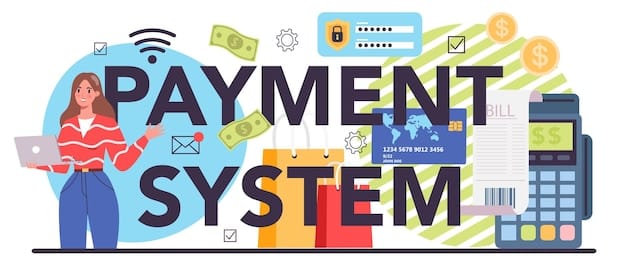Will CBDCs Replace Traditional Payment Systems in the US?

Will Central Bank Digital Currencies (CBDCs) Replace Traditional Payment Systems in the US? This is a complex question, with no definitive answer currently. CBDCs offer potential benefits like increased efficiency and financial inclusion, but challenges remain in terms of security, privacy, and integration with existing systems.
The landscape of finance is constantly evolving, with technological advancements reshaping how we perceive and interact with money. Among these innovations, Central Bank Digital Currencies (CBDCs) have emerged as a potentially transformative force. The question many are asking is: Will Central Bank Digital Currencies (CBDCs) Replace Traditional Payment Systems in the US?
Examining the potential impact of CBDCs on traditional payment methods like credit cards and cash requires a deep dive into the technology, its potential benefits, and the challenges that lie ahead. This article explores the likelihood of Central Bank Digital Currencies replacing existing payment systems in the United States.
Understanding Central Bank Digital Currencies (CBDCs)
Central Bank Digital Currencies, often abbreviated as CBDCs, represent a new form of digital money issued and backed by a nation’s central bank. Unlike cryptocurrencies like Bitcoin, which operate on decentralized networks, CBDCs are centralized, meaning they are controlled and regulated by the monetary authority. This difference is crucial in understanding their potential role in the financial system.
How CBDCs Differ From Cryptocurrencies
The key distinction lies in the level of control and regulation. Cryptocurrencies are typically decentralized, meaning no single entity governs them. CBDCs, on the other hand, are centralized and backed by the full faith and credit of the issuing government. This backing provides stability and trust, which are essential for widespread adoption.
- Centralized Control: CBDCs are monitored and regulated by the central bank.
- Government Backing: They are backed by the government, providing stability.
- Potential for Regulation: CBDCs can be subject to regulatory oversight and compliance.
CBDCs also aim to offer secure and efficient payment solutions, leveraging the benefits of digital technology while mitigating the risks associated with decentralized cryptocurrencies. They are designed to integrate seamlessly with existing financial infrastructure while offering enhanced security and faster transaction processing.

The Potential Benefits of CBDCs in the US
Introducing CBDCs in the US could unlock several significant benefits, impacting everything from financial inclusion to the efficiency of payment systems. These potential advantages are driving much of the discussion and exploration into CBDCs by policymakers and financial institutions alike.
Enhancing Financial Inclusion
One of the most promising aspects of CBDCs is their potential to bring more people into the formal financial system. Millions of Americans are unbanked or underbanked, lacking access to basic financial services. CBDCs could provide a low-cost, accessible alternative to traditional banking, enabling more people to participate in the digital economy.
CBDCs could offer a digital wallet directly accessible to individuals, reducing the dependency on traditional banks. This accessibility could particularly benefit low-income communities and those living in remote areas with limited banking infrastructure. By lowering the barriers to entry, CBDCs can promote greater financial equity and opportunity. Will Central Bank Digital Currencies (CBDCs) Replace Traditional Payment Systems in the US? It’s possible, but the enhanced financial inclusion is a great start.
- Reduced Dependency on Banks: Direct access to digital wallets.
- Lower Costs: Eliminates fees associated with traditional banking services.
- Accessibility: Reaches underserved communities and remote areas.
Improving Payment System Efficiency
CBDCs have the potential to modernize and streamline the US payment system. Traditional payment methods often involve intermediaries and can be slow and costly. CBDCs could enable faster, cheaper, and more transparent transactions, benefiting both consumers and businesses.
Real-time payments, reduced transaction fees, and increased transparency are just a few potential improvements. CBDCs could also facilitate cross-border payments, making international transactions quicker and more efficient. By cutting out intermediaries and leveraging digital technology, CBDCs can significantly enhance the overall efficiency of the payment system.

Challenges and Concerns Surrounding CBDCs
Despite the potential benefits, the introduction of CBDCs also raises significant challenges and concerns. Privacy, security, and the potential impact on the banking sector are among the key issues that need to be carefully addressed before CBDCs can be widely adopted.
Addressing Privacy Concerns
One of the primary concerns surrounding CBDCs is the potential for government surveillance and intrusion into personal financial matters. Because CBDCs would be issued and controlled by the central bank, there is a risk that the government could track and monitor every transaction. Balancing the need for transparency with the protection of individual privacy is a critical challenge.
Implementing robust privacy safeguards, such as advanced encryption and data anonymization techniques, is essential. Clear legal frameworks and regulations are needed to ensure that CBDCs are used in a way that respects individual privacy rights and prevents abuse of power.
Without adequate privacy protections, public trust in CBDCs could be undermined, hindering their adoption and effectiveness. Therefore, addressing privacy concerns is paramount to the successful implementation of CBDCs. Perhaps Will Central Bank Digital Currencies (CBDCs) Replace Traditional Payment Systems in the US?, but the focus should remain on privacy concerns.
Mitigating Security Risks
Security is another major concern. As with any digital system, CBDCs are vulnerable to cyberattacks and fraud. Protecting the integrity of the CBDC network and ensuring the security of digital wallets is crucial to maintaining trust and confidence in the system. Implementing robust security measures, such as multi-factor authentication and advanced threat detection systems, is essential.
Developing cybersecurity protocols, conducting regular security audits, and collaborating with cybersecurity experts can help mitigate these risks. It’s also important to educate users about best practices for protecting their digital wallets and avoiding phishing scams.
The Role of Traditional Payment Systems in the Future
While CBDCs offer numerous advantages, traditional payment systems are not likely to disappear entirely. Credit cards, debit cards, and cash still play a vital role in the US economy, and each has unique strengths that make them valuable to consumers and businesses.
The Resilience of Cash
Despite the rise of digital payments, cash remains a popular choice for many Americans, particularly for small transactions and those who prefer the anonymity and security of physical currency. Cash also serves as a backup during power outages or cyberattacks when digital payment systems may be unavailable.
- Anonymity: Cash transactions are not recorded electronically, providing privacy.
- Accessibility: Cash is universally accepted and does not require a bank account.
- Backup: It serves as a reliable payment method during emergencies.
The Convenience of Credit and Debit Cards
Credit and debit cards offer convenience, rewards programs, and fraud protection. They are widely accepted by merchants and are an integral part of the modern economy. While CBDCs could potentially offer similar or even better features, widespread adoption may take time, and existing card systems are likely to remain relevant for the foreseeable future.
The Path Forward: Integration or Replacement?
The question of whether Will Central Bank Digital Currencies (CBDCs) Replace Traditional Payment Systems in the US? remains a subject of debate. Some experts believe that CBDCs could eventually replace traditional payment methods, while others argue for a more integrated approach, where CBDCs coexist alongside existing systems. The ultimate path forward will likely depend on a variety of factors, including technological advancements, regulatory decisions, and consumer adoption.
A Gradual Integration Approach
One potential scenario is a gradual integration of CBDCs into the existing financial ecosystem. This approach would involve developing interoperability standards that allow CBDCs to work seamlessly with traditional payment systems. It would also require collaboration between central banks, commercial banks, and payment processors to ensure a smooth transition.
This phased approach could minimize disruption and allow consumers and businesses to gradually adopt CBDCs at their own pace. It would also provide an opportunity to address any unforeseen challenges and make adjustments as needed. This is especially important should central banks need assistance adjusting the Will Central Bank Digital Currencies (CBDCs) Replace Traditional Payment Systems in the US? discussion to changing political headwinds.
| Key Point | Brief Description |
|---|---|
| 💰 CBDC Benefits | Enhance inclusion, improve efficiency. |
| 🔒 Security | Mitigating cyber risks is crucial for CBDCs. |
| 🏦 Traditional Payments | Cash and cards still important. |
| 🤝 Integration | Gradual integration of CBDCs may be ideal. |
Frequently Asked Questions
CBDCs can enhance financial inclusion by providing access to digital wallets for unbanked populations. They can also improve payment system efficiency through faster and cheaper transactions.
CBDCs are centralized and issued by a central bank, providing stability and regulatory oversight. Cryptocurrencies, like Bitcoin, are decentralized and operate on blockchain technology without central authority.
Privacy and security are major concerns. The potential for government surveillance and the risk of cyberattacks need to be addressed to ensure public trust and prevent abuse.
Traditional payment methods are unlikely to disappear entirely. Cash offers anonymity, while credit cards provide convenience and rewards, suggesting a coexistence rather than a complete replacement.
CBDCs could offer consumers faster, cheaper, and more secure payment options. They also have the potential to reduce dependency on traditional banks and promote financial inclusion.
Conclusion
In conclusion, the question of Will Central Bank Digital Currencies (CBDCs) Replace Traditional Payment Systems in the US? is complex and multifaceted. While CBDCs offer potential benefits such as increased efficiency and financial inclusion, significant challenges related to privacy and security must be addressed.
The future likely involves a gradual integration of CBDCs alongside existing payment methods, rather than a complete replacement. This approach would allow consumers and businesses to adapt at their own pace while minimizing disruption to the financial system.





